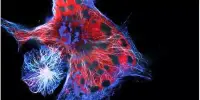Residents and tourists to the Norwegian region of Hessdalen have been reporting odd orbs of light in the sky since at least the 1930s.
While some sightings are actually of explainable phenomena, such as “planes,” and reports of the lights can be easily dismissed as UFOlogy nonsense (especially when some write “papers” questioning whether the lights could actually be wormholes), the lights have been consistently seen over the years, both during the day and at night, and have been extensively photographed.
A small group of researchers from the Universities of Oslo, Bergen, and the Norwegian Defence Research Establishment are working to record and explain the lights. According to computer scientist Erling Strand, the lights abruptly halted in 1983 before resuming in 1984.
Strand and his crew evaluated the event using radar, a magnetometer, a radio-spectrum analyzer, a seismograph, cameras, a Geiger counter, and an infrared camera before setting up a fixed observatory to record additional occurrences.
The lights can move steadily or occasionally dash around and take a random route, and they can last anywhere between a few seconds and over an hour, according to the data gathered and witness accounts. They have been reported as being the size of a car in cases where size has been approximated.
What is the root of them? Although we can’t say for sure, there are a lot of intriguing (and entertaining) ideas.
Given that Hessdalen valley (and Norway as a whole) have one of the greatest radon amounts in Europe, one hypothesis, advanced in a 2010 article published in the Journal of Atmospheric and Solar-Terrestrial Physics, proposes that the occurrence is caused by radon decaying in the atmosphere.
While intriguing, a more seductive theory that was first put forth in 2006 suggests that the occurrence may be brought on by the landscape serving as a natural battery that discharges at set times. A watercourse divides the Hessdalen basin in half, with copper- and zinc-rich rocks on one side and iron- and zinc-rich rocks on the other.
The zinc/iron portion would serve as the electrode and the copper portion would serve as the cathode in this “perfect natural battery.”
The only thing the battery needs to transfer energy between its two parts is an electrolyte solution.
The local sulphur mines’ rediscovery in 2012 provided the final piece of evidence needed to back the ‘natural battery concept. They were closed because the mining business went bankrupt after being operational until 1933,” a group noted in 2013.
“We now speculate that sulphuric acid may be present in the torrents emerging from the mines and flowing into the Hesja river.”
The researchers reported that magnetic field anomalies in the region have been found to be compatible with a natural battery. Although the team “speculatively suggests that the local characteristics of the valley lead to the production of cold plasmas and/or ion bubbles,” it is unknown how a natural battery would generate enough charge to create such visible lights.
There is still no agreement on what is producing the lights, and it is also unknown whether the valley is functioning as a massive battery, possibly as large as the fabled single-A.
















